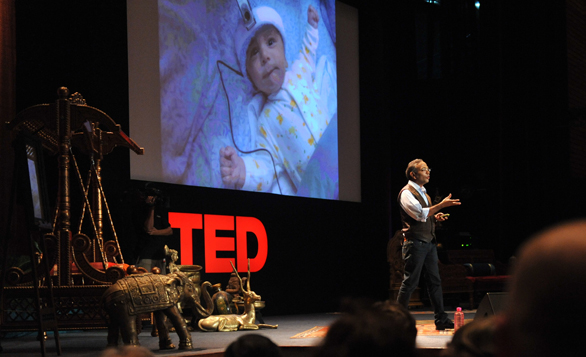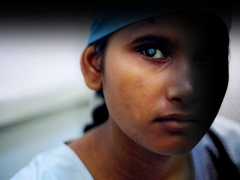
Pawan Sinha explains how the brain learns to see at TEDIndia 2009. Now, he’s given the backstory to his area of research. Photo: James Duncan Davidson
In the most recent issue of Scientific American, Pawan Sinha shares the eye-opening experience that shook his worldview.
When riding through the streets of New Delhi one night in 2002, Sinha’s cab slowed for a red light by a struggling family sitting on the side of the road. Both of the children, emaciated and barefoot, had eye cataracts. After Sinha gave the family some money, the cab pulled away … but the children’s eyes burned into Sinha’s memory.
 Pawan Sinha: How brains learn to see
Inspired by these children, Sinha began to learn the shocking facts of childhood blindness in India — some of which he shared in his talk from TEDIndia 2009. Almost 400,000 children in India are blind. More than half of them die within a year of becoming blind, and less than 10 percent of these children are educated. Blind children have limited access to reliable treatment. And young females face an even more dire reality: many are physically or sexually abused at home.
Pawan Sinha: How brains learn to see
Inspired by these children, Sinha began to learn the shocking facts of childhood blindness in India — some of which he shared in his talk from TEDIndia 2009. Almost 400,000 children in India are blind. More than half of them die within a year of becoming blind, and less than 10 percent of these children are educated. Blind children have limited access to reliable treatment. And young females face an even more dire reality: many are physically or sexually abused at home.
“My experience on that winter afternoon in New Delhi marked the beginnings of a personal journey that has yet to end,” writes Sinha in the article. “I resolved to help these blind children gain sight. And as a scientist, I realized that doing so presented a valuable opportunity to answer one of the most challenging questions in neuroscience: How does the brain learn to see?”
Since 2002, Sinha has brought sight to 200 children in India. Both this article and his talk describe his research on visual processing, which has driven the work of Project Prakash, an organization that helps blind children see. The organization’s two-pronged process performs cataract operations and teaches children to parse images into objects, building on Sinha’s breakthrough research on dynamic information processing.
“Our ability to partition an image into separate objects is so well-honed that it seems effortless. We open our eyes, and the world falls into place, an orderly collection of things. Yet we have found that the experience of a Prakash child soon after gaining sight is different. The newly-sighted exhibit profound impairments,” writes Sinha. “They are unable to organize the many regions of different colors and brightness into larger assemblies. Many features of ordinary objects—the overlapping sections of two squares or a section of a ball delineated by the lacing on its surface—are perceived as entirely separate objects, not component parts of larger structures. It is as if the visual scene for a newly-sighted person is a collage of many unrelated areas of color and luminance, akin to an abstract painting. This perceptual overfragmentation makes it difficult to detect whole objects.”
Sinha’s research has found an answer to this problem. Motion may train the optical system to parse images, even when a person is still. “With the rule ‘things that move together belong together,’ a person’s visual system can eventually learn to group images via static attributes such as color and orientation,” he writes.
Project Prakash has integrated this cutting-edge research into its recovery therapy, and has created a successful model to brighten the lives of Indian children.
“My students and I derive great satisfaction from the findings that have emerged from Project Prakash, but the work has also affected us on a deeper, more personal, level,” writes Sinha. “Each blind child with whom we have worked has presented a unique story of hardships and social isolation. Equally unique is the change each child’s life undergoes after treatment … Given the magnitude of the problem, however, this is only a beginning.”
Read the full text of the Scientific American article here (subscription required) »
Comments (2)